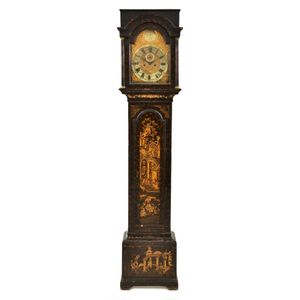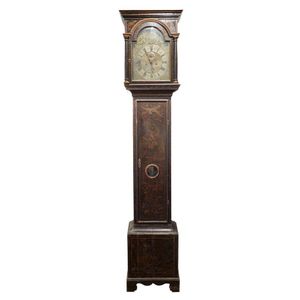Chinoiserie Black Japanned Longcase Clock, 1750
You must be a subscriber, and be logged in to view price and dealer details.
Subscribe Now to view actual auction price for this item
When you subscribe, you have the option of setting the currency in which to display prices to $Au, $US, $NZ or Stg.
- Circa - A Latin term meaning 'about', often used in the antique trade to give an approximate date for the piece, usually considered to be five years on either side of the circa year. Thus, circa 1900 means the piece was made about 1900, probably between 1895 and 1905. The expression is sometimes abbreviated to c.1900.
- Japanning - Japanning is the early eighteenth century technique used by European craftsmen to imitate the oriental style lacquer work that became popular in England, France, the Netherlands, and Spain in the 17th century.
The lacquer used was based on the lac beetle dissolved in alcohol (as used in French polish) and differed from the Chinese lacquer which was based on tree sap.
Each layer of the lacquer was allowed to dry and then sanded down. It was applied over cream, yellow, green, red, or black grounds. Japanning using gold leaf was also widely used with lacquer work. The technique can be found on bureaux, cabinets, chests, longcase clocks, and chairs. - Chinoiserie - Furniture and decorative items decorated in imitation of a Western interpretation of the Chinese style. The Chinoiserie style first became popular in the late 17th century, though there were frequent revivals, notably by Chippendale (hence 'Chinese Chippendale') during the Regency period, and the Anglo-Japanese style in the second half of the 19th century.
The ubiquitous 'willow pattern' is the most common 'Chinese' theme used in porcelain, while on furniture the Chinoiserie style usually has black or red painted and lacquered decoration, though the hallmark of the furniture style is the use of fretwork in geometrical patterns, pagodas and other decorative forms.
Japonaiseries, as the name implies, are motifs in imitation of the Japanese taste.
See also "Chinese Chippendale". - George Ii - George II (1683 - 1760) was King of Great Britain and Ireland from 1727 until his death in 1760.
This item has been included into following indexes:
Visually similar items

A George III mahogany longcase clock the dial signed John Tickell, Crediton, the brass Roman numeral moon phase dial with subsidiary seconds dial, housing an anchor escapement on one bell, heavy wear and veneer losses to case, 122 cm high

A good highly decorative George III black lacquer chinoiserie longcase clock, the brass dial with Roman numerals, subsidiary seconds dial and date aperture, the maker noted 'Andren Moran London', applied pierced, scroll and mask cast panels to the quadrant

A George III mahogany longcase clock, the dial signed William Lee, Leicester the brass Roman numeral dial with subsidiary seconds dial and calendar, housing an anchor escapement on one bell, 223.5 cm high

A Chinoiserie long case clock, John Anderson Wigton, the gilded black lacquered case decorated with a Chinese court scene on a simulated tortoise shell ground, the shaped glazed door enclosing an engraved and silvered dial with Romana and Arabic numerals o
